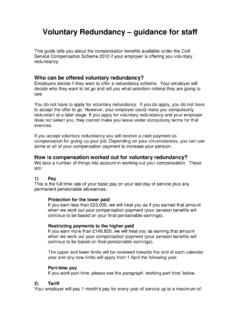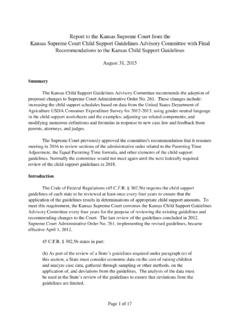Transcription of premium pension scheme
1 premium pension schemeA guide to available benefitsContentsIntroduction 3 Paying for your pension 4 How your pension is worked out 6 Joining up previous pensions 8 Boosting your pension 10 Leaving the scheme (before retiring) 11 Retiring 13 Benefits for your dependants 15 Other information 17 Technical terms 21 Note: This booklet does not cover every aspect. Full details are contained in the rules, which are the legal basis of the scheme . Nothing in this booklet can override them and, in the event of any difference, the rules will apply. You should bear in mind that the booklet is based on the rules in force at the time of publication; your pension benefits will be worked out using the rules relevant to your period of we have had to use technical terms, we show them in bold and explain them in the back of the is premium and who can get it?
2 premium is an occupational defined benefit pension scheme . It provides a way of saving for your retirement. Over the years, you and your employer both make contributions to the scheme . When you retire, we pay you a pension based on the years you contributed to the scheme and on your pensionable earnings in your final years of was closed to new entrants from 30 July 2007 onwards but is still offered to people who are re-employed by an organisation that participates in the Civil Service pensions arrangements and who: resigned or was made redundant from their previous Civil Service employment have a preserved premium , classic or classic plus pension are returning within five years (so long as the break between the employments has been more than 28 days) are not receiving their Civil Service pension . Rejoiners who left with an exit package of some sort, for example, received a redundancy payment, may also be offered premium although they may have to repay some or all of that payment, depending on the length between employments.
3 If someone rejoins within 28 days, they rejoin the pension scheme they were in; in effect, they are treated as if their service is continuous (so long as they aren t receiving their pension ).People who left their previous Civil Service post because of ill health retirement and are receiving an upper-tier pension are not eligible to rejoin or become a member of any of the Civil Service pension schemes. 3 Introduction4 You also need to be aware that your pensionable earnings may be limited to the earnings cap unless you joined the Civil Service pension arrangements before 1 June 1989. MyCSP can give you more information. How much will my employer pay? Your employer makes significant contributions to your premium pension . The contributions are set at a level advised by the scheme actuary to provide enough funds to pay the pension as I get tax relief? You pay your contributions out of your gross pay (before income tax), so the cost to you is about National Insurance?
4 Up to 6 April 2016 premium was contracted-out of the state scheme . This means that both you and your employer paid National Insurance contributions at the lower rate. Employers who provided pension schemes that were contracted out of the State Second pension (S2P) have reference numbers. The following numbers are relevant to your employment: Employer s contracting-out number: E3900004Y scheme s contracting-out numbers: S2730001 DBefore 6 April 2016 you did not build up any rights to S2P while you were a member of premium , although you will still get the basic State Retirement pension if you have paid enough National Insurance much will I pay?You will pay a variable contribution rate dependant upon your pensionable earnings. Details of the amount you will pay can be found on earnings are pensionable? As a general rule, only permanent items of pay are pensionable. This includes any allowances that your employer tells you are pensionable, but will not include payments such as payments do not normally count as pensionable earnings.
5 But if you receive pensionable bonus payments, both you and your employer will pay contributions on them. You may also have some non-cash pensionable earnings for example, some people s pensions will take account of a uniform allowance, and others may have an allowance for accommodation. In these circumstances you and your employer will also pay contributions based on the equivalent cash value of these non-cash pensionable you are on reduced pay during maternity leave (and in certain other circumstances) your employer will make contributions based on the pay that you would have expected if you were not off work. Your contributions will be based on your reduced pay. If you are a high earner, you need to be aware that there are limits on your pension contributions and their resulting benefits. If you exceed the limits you will have to pay extra tax. Paying for your pension5 What if I have periods off work? You can usually only pay contributions and build up reckonable service if you are actually working.
6 The main exception to this is certain periods of statutory maternity leave which count as reckonable your employer allows you to take a career break you will continue to be a member of the scheme although neither you nor your employer will pay contributions and you will not build up reckonable service during this you are off work on long-term sick leave you will continue to build up reckonable service while you are receiving sick pay at full or half your pension is worked out What if I work part-time? If you work part-time we will work out your pension by using a full-time equivalent rate for your pensionable earnings and by counting your reckonable service on the basis of the time you actually work. This gives a fair result as it allows us to add together periods of full-time and part-time service. In particular, you are not disadvantaged if you move to part-time working in the run-up to your works full-time for 25 years and then works part-time (18 hours a week instead of the full-time 36 hours) for 10 years.
7 When Jenny retires, her actual pensionable earnings in the last 12 months are 10, s final pensionable earnings = 10,000 x 36/18 = 20,000 Jenny s reckonable service = 25 + (10 x 18/36) = 30 yearsJenny s pension = 1/60 x 20,000 x 30 = 10,000 a yearWe work out your pension as 1/60 of your final pensionable earnings for every year of reckonable service in the leaves premium after 20 years reckonable service. His final pensionable earnings are 18,000 a s premium pension = 1/60 x 20 x 18,000 = 6,000 a yearThe maximum length of reckonable service that can count towards your pension is 45 years. However, before 1 March 2008, the number of years was restricted to 40 years. So, if you had built up 40 years before 1 March 2008, you could not build up any more pension until after that you were a member of classic on 30 September 2002 and chose to join premium from 1 October 2002 your reckonable service in classic will have been converted into premium reckonable service.
8 You will have been told at the time how many years of reckonable service you would receive in premium in exchange for your years of classic reckonable most cases the conversion rate will have been years of premium reckonable service for every year in classic but, depending on your circumstances, you may have had slightly less. 7 ExampleTom retires after 30 years service with a pension of 10,000 a has an option to take a tax-free lump sum of up to 42, If Tom chooses to take the maximum tax-free lump sum, he will have to give up a pension of 3, a year. This means that Tom can choose: a pension of 10,000 a year; or a maximum single tax-free lump sum of 42, plus a pension of 6, ; or some other combination of pension and lump sum up to the maximum your annual pension in this way generally has no impact on your dependants pensions as these are based on your pension before you give any up for a higher lump sum. However, if you are aged 75 or over when you die, the tax rules on pensions will restrict the total of any dependants pensions payable to a maximum of the amount of your pension at the date of your death.
9 As taking a higher lump sum reduces your pension , this might lead to your dependants pensions being reduced if you die after reaching 75, but this is only likely to be an issue if you leave two or more children under age 18 (or under age 23 if they are in full-time education).How will I know what my pension will be?Each year, MyCSP will send you an annual benefit statement which will show how much pension you have earned to date, and your projected pension to scheme pension age, based on your current salary. The statement shows your personal details on which the projections are based, so that you can check that these are you approach pension age you will receive a statement of the benefits payable to you. If you leave before pension age you will continue to receive an annual benefit statement (providing you keep your address up to date).Do I get a tax-free lump sum?At the time you retire you can choose, under current rules, to give up part of your pension for a tax-free lump sum.
10 You can choose how much lump sum you want, up to a maximum of 30/7 x your pension , but you must give up 1 of pension for each 12 of lump can find out how much lump sum you can take, and the effect it will have on your pension by using the calculator on the Civil Service website (or you can ask MyCSP to do this for you if you do not have access to the calculator).8 Joining up previous pensions Public Sector Transfer Club a guide for scheme members . If you join the Civil Service and want to bring in a transfer from a scheme in the PSTC, you must do this within 12 months of being eligible to join have a preserved pension from when I previously worked in the Civil Service. What happens to that?If you have preserved benefits in classic, classic plus or premium from a previous period of employment, you can either leave your earlier pension preserved or you can aggregate (join up) your earlier period of service with your current service for a single pension based on your final pensionable earnings when you next leave the scheme .

![The [January 2017] Public Sector Transfer Club](/cache/preview/e/e/4/7/c/f/7/1/thumb-ee47cf71e222419f4d4650799ef4cd2a.jpg)


![The [January 2018] Public Sector Transfer Club](/cache/preview/a/2/a/c/a/3/1/4/thumb-a2aca3146a5eaf5d87fff577a897dab7.jpg)







